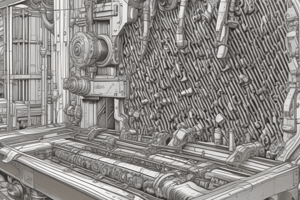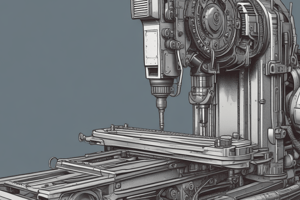Podcast
Questions and Answers
In a plain milling machine, what movement is not possible in a horizontal plane?
In a plain milling machine, what movement is not possible in a horizontal plane?
- Cross
- Vertical
- Longitudinal
- Swivel (correct)
What distinguishes a universal milling machine from a plain milling machine?
What distinguishes a universal milling machine from a plain milling machine?
- High-speed spindle rotation
- Ability to perform angular and helical milling operations (correct)
- Fixed table orientation
- Limited feeding directions
What type of milling machine has the cutter spindle positioned vertically?
What type of milling machine has the cutter spindle positioned vertically?
- Drum type milling machine
- Horizontal bed milling machine
- Universal vertical milling machine (correct)
- Turret ram type milling machine
What distinguishes a peripheral milling operation from a face milling operation?
What distinguishes a peripheral milling operation from a face milling operation?
What is the main function of an arbor in milling operations?
What is the main function of an arbor in milling operations?
What is a defining feature of a universal milling machine compared to other types of milling machines?
What is a defining feature of a universal milling machine compared to other types of milling machines?
What is the formula to convert spindle rotation speed to spindle velocity in milling?
What is the formula to convert spindle rotation speed to spindle velocity in milling?
How is the feed rate in milling calculated when given the feed per cutter tooth?
How is the feed rate in milling calculated when given the feed per cutter tooth?
What is the formula to determine the material removal rate in a slab-milling operation?
What is the formula to determine the material removal rate in a slab-milling operation?
How is the approach distance calculated to fully engage the cutter in a slab cutting operation?
How is the approach distance calculated to fully engage the cutter in a slab cutting operation?
Flashcards are hidden until you start studying





